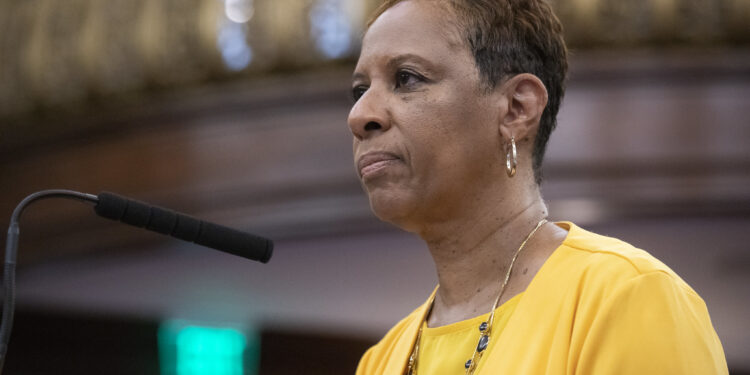New York City Mayor Eric Adams and his General Counsel, Lisa Zornberg, have firmly stated that the city does not practice solitary confinement in its jails, contrary to various reports and statements.
In a press briefing on Tuesday, Mayor Adams said, “We keep using this term, and I don’t know how many times I have to correct it. We don’t have solitary confinement in New York City.”
He further explained, “That was a bait and switch where people took an emotional terminology and they put it out there, and all of us started buying into it.”
The mayor expressed concern over the negative light cast on the city due to misusing the term solitary confinement in speeches and statements.
He stressed, “We don’t have solitary confinement. They knew everybody was going to hold on to that terminology and make it seem like, ‘my God, how could you do solitary confinement?’”
The City Council and Public Advocate Jumaane Williams have been using the term solitary confinement in their statements regarding Bill 549-A, giving the impression that inmates are kept in their cells for 22 hours a day.
However, this is contrary to the actual practices in New York City jails which use restrictive housing.
Understanding Solitary Confinement and NYC’s Current Practices
The United Nations defines solitary confinement as when an individual spends 22 hours in their cell and is allowed a maximum of two hours outside the cell. However, New York City has not practiced any form of solitary confinement since 2019.
General Counsel Lisa Zornberg highlighted in Tuesday’s briefing that the city has “one of the most liberal policies of any large jail system in the United States,” where the general population in jail is allowed 14 hours out of cell in a day.
Compared to other major cities, inmates in Chicago’s general population are allowed six hours outside their cells daily. This figure decreases in Philadelphia and Washington, D.C., where inmates are permitted only five hours of out-of-cell time.
Zornberg explained, “The local law that was passed, in sharp contrast to the United Nations’ own definition, arbitrarily adopted a definition of its own, saying that anything less than being out of cell 14 hours a day is solitary confinement. That’s what the local law says. So if you’re allowed out of your cell 13 hours a day, Local Law 42 labels that as solitary confinement. That is not remotely solitary confinement.”
She added, “The media really does have to stop calling this a law about banning solitary confinement. It’s false branding. It’s confusing the issue for the public.”
The Controversy Surrounding Bill 549-A
NYC Bill 549-A, which aims to ban solitary confinement in city jails, was passed by the New York City Council on December 20, 2023. Sponsored by Public Advocate Jumaane Williams, the legislation was introduced as a response to concerns about the negative impacts of solitary confinement, including its psychological and emotional harms.
The bill specifies that detainees should have at least 14 hours of out-of-cell time in shared spaces daily, and solitary confinement can only be used in exceptional circumstances to separate individuals from the general population.
Supporters of the bill often draw comparisons to the tragic case of Kalief Browder, who died in 2015 after experiencing prolonged isolation for 800 days.
Despite its passage, Mayor Adams vetoed the bill, citing safety concerns for both incarcerated individuals and staff.
Critics of the bill, including the Correction Officers’ Benevolent Association (COBA), argue that eliminating solitary confinement for violent offenders would increase the risk of attacks on other inmates and guards, potentially worsening conditions at the troubled Rikers Island jail complex.
According to the union, 6,500 New York City Department of Correction (DOC) officers have been assaulted by inmates at Rikers Island and other jails over the past three years.
Zornberg emphasized the potential dangers of the legislation: “The law as written would prohibit the Department of Corrections from operating a restrictive housing program, a separation housing unit, and de-escalation housing. Three forms of housing that are essential to safely run the jails and separate individuals who are violent.”
She provided an example of a scenario where the legislation could hinder safety measures: “If a body scan reveals that a person in custody has secreted a weapon on or inside their person and they’re refusing to relinquish it, they are removed from the general population until they become cooperative or until the weapon is surrendered. But the legislation would prevent that.”
This legislation, if enacted, would also prohibit correction officers from restraining detainees while transporting them to and from court.
Highlighting safety concerns, Zornberg noted that it is standard practice for police officers to restrain individuals, particularly those arrested for violent offenses, to prevent harm to either the transport driver or the officers.
In a January letter to The New York Times, Zornberg wrote, “Mayor Eric Adams is determined to support the safety of correction officers and those in their custody. That is why he vetoed the legislation.”
DOC Commissioner Maginley-Liddie’s Response
NYC DOC Commissioner Lynelle Maginley-Liddie also criticized Bill 549-A, suggesting it could lead to increased violence within facilities.
“The bill removes all consequences for those who commit violent acts in our facilities. It eliminates our ability to hold violent offenders accountable,” Maginley-Liddie stated in a January video statement.
The commissioner continued, “Let’s be clear, everyone wants our jails to be safe and the people in our care treated fairly. That means the safety of our staff and detainees must be our paramount concern. We can’t sacrifice that for politics.”
Federal Monitor’s Letter on the Law
The federal monitor overseeing Rikers has also strongly opposed the bill, stating it would heighten safety risks to those who work and live there.
In a January letter, the federal monitor stated that the bill would only “exacerbate the already dangerous conditions” behind bars.
The monitor’s letter to the DOC, dated July 17, 2024, outlines several critical issues with Local Law 42, particularly its potential impact on facility safety and management discretion.
The monitor warns that certain provisions of the law could paradoxically increase the risk of harm to both incarcerated individuals and staff.
“An overarching concern of the Monitoring Team is that the requirements of LL42 impose absolute prohibitions on correctional management that remove all discretion in a number of particularized circumstances where some degree of latitude and discretion in judgment to manage immediate threats to security are in fact necessary,” the letter states.
The monitor emphasizes that while the law aims to provide safeguards for those in restrictive housing, it may inadvertently limit the ability of correctional managers to address immediate security threats. This limitation, according to the monitor, could compromise the safety of everyone within the facilities.
In response to these concerns, the city administration issued a temporary Executive Emergency Order last Saturday to protect public safety by temporarily suspending or modifying the most dangerous parts of Local Law 42 while the federal monitor conducts necessary work.
City Hall Statement
In a statement, the City Hall spokesperson stated that the DOC is working hard to decrease violence in jails to keep both inmates and staff safe.
The statement reads, “The Department of Correction has been laser-focused on reducing violence in our jails to protect both the people in our care and correctional staff who boldly serve our city.”
It concluded, “The federal monitor appointed under the Nunez consent decree has now stated in writing multiple times that attempting to implement Local Law 42 at this time ‘would be dangerous’ for those who live and work in our jails. To protect public health and safety in our jails, and to ensure full compliance with the federal monitor and Nunez court orders while the monitor undertakes additional court-directed analysis, the mayor has issued this narrowly-tailored executive order.”









